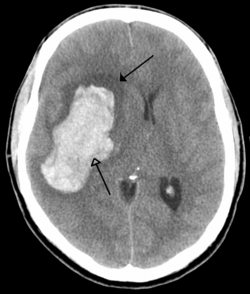Medicine:Pediatric stroke
Pediatric stroke is a stroke that happens in children or adolescents. Stroke affects about 6 in 100,000 children.
Pediatric stroke causes can and does happen at any age. Stroke is different in children and newborns than it is in adults. Children have hemorrhagic strokes as often as they have ischemic strokes, while adults are more likely to have ischemic strokes. Sixty percent of pediatric strokes occur in boys. Causes of stroke are also different in children than they are in adults.
Types of Strokes
Ischemic
In an ischemic stroke, blood supply to part of the brain is decreased, leading to dysfunction of the brain tissue in that area. There are four reasons why this might happen:
- Thrombosis (obstruction of a blood vessel by a blood clot forming locally)
- Embolism (obstruction due to an embolus from elsewhere in the body, see below),
- Systemic hypoperfusion (general decrease in blood supply, e.g., in shock)[1]
- Venous thrombosis.[2]
Stroke without an obvious explanation is termed "cryptogenic" (of unknown origin); this constitutes 30-40% of all ischemic strokes.[3][4]
Hemorrhagic
Intracranial hemorrhage is the accumulation of blood anywhere within the skull vault. A distinction is made between intra-axial hemorrhage (blood inside the brain) and extra-axial hemorrhage (blood inside the skull but outside the brain). Intra-axial hemorrhage is due to intraparenchymal hemorrhage or intraventricular hemorrhage (blood in the ventricular system). The main types of extra-axial hemorrhage are epidural hematoma (bleeding between the dura mater and the skull), subdural hematoma (in the subdural space) and subarachnoid hemorrhage (between the arachnoid mater and pia mater). Most of the hemorrhagic stroke syndromes have specific symptoms (e.g., headache, previous head injury).[citation needed]
Symptoms and signs
Symptoms often include:[citation needed]
- Seizures, especially in newborns
- Keeping one hand in a fist position, especially in infants
- Worsening or sudden headaches
- Sudden difficulty speaking, slurring of words or trouble understanding speech
- Hemiparesis, or a weakness on one side of the body
- Sudden loss of vision or abnormal eye movements
- Sudden loss of balance or trouble walking
Prognosis
The prognosis for pediatric stroke survivors varies. The following are some common outcomes:[citation needed]
- Cerebral Palsy (often Hemiplegic Cerebral Palsy/Hemiplegia)
- Epilepsy
- Vision Loss
- Hearing Loss
Treatment of Pediatric Stroke
- If symptoms of pediatric stroke seizure are seen, the infant should be taken to the hospital immediately for assessment, diagnosis, and treatment.
- Medications and other treatments may be recommended to help treat the symptoms (e.g. to control seizures) or correct the cause of the stroke, such as rehydration, antibiotics for meningitis, and, medication or surgery to correct heart abnormalities.
References
- ↑ "Mechanisms and management of stroke in the elderly". CMAJ 145 (5): 433–43. September 1991. PMID 1878825.
- ↑ Stam J (April 2005). "Thrombosis of the cerebral veins and sinuses". The New England Journal of Medicine 352 (17): 1791–8. doi:10.1056/NEJMra042354. PMID 15858188. https://pure.uva.nl/ws/files/3830901/45867_208116y.pdf.
- ↑ (Donnan ref missing)[1]
- ↑ "Cryptogenic stroke: time to determine aetiology". Journal of Thrombosis and Haemostasis 6 (4): 549–54. April 2008. doi:10.1111/j.1538-7836.2008.02903.x. PMID 18208534.
 |


